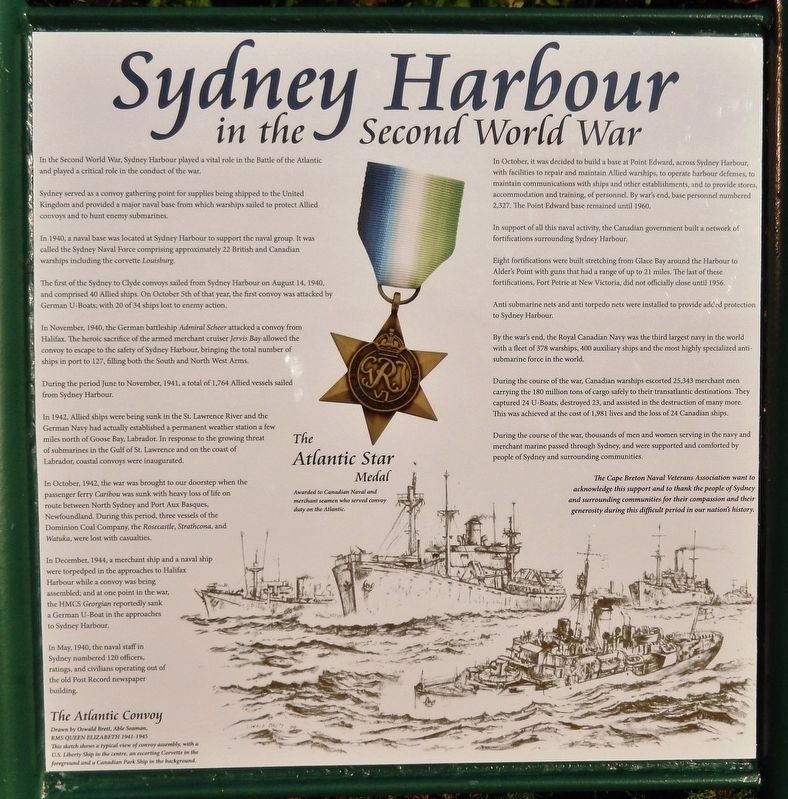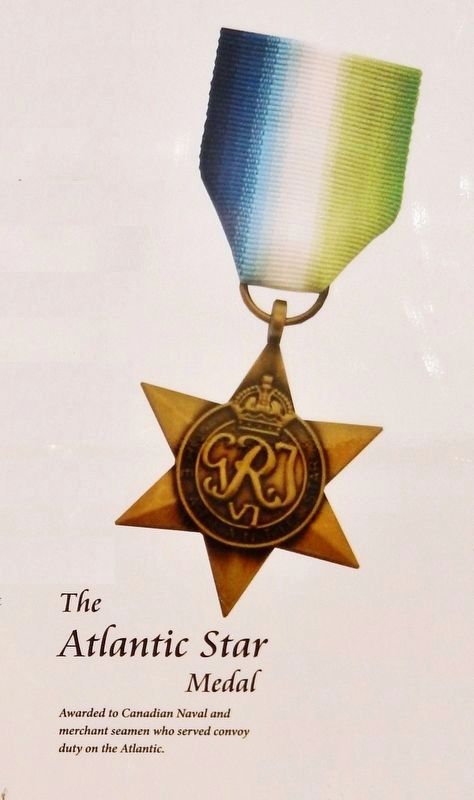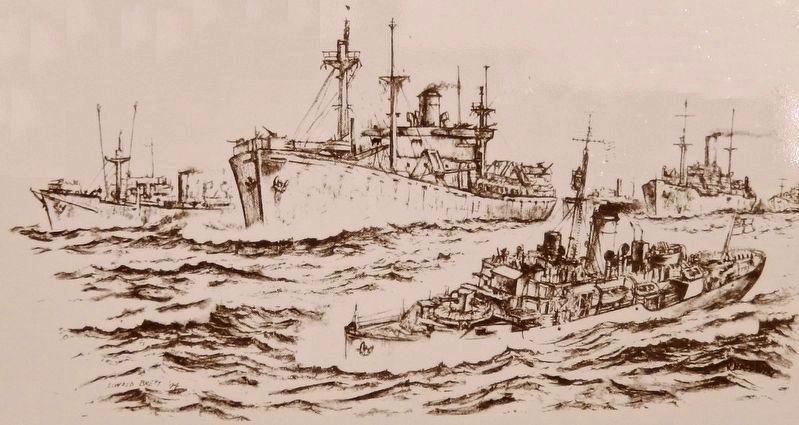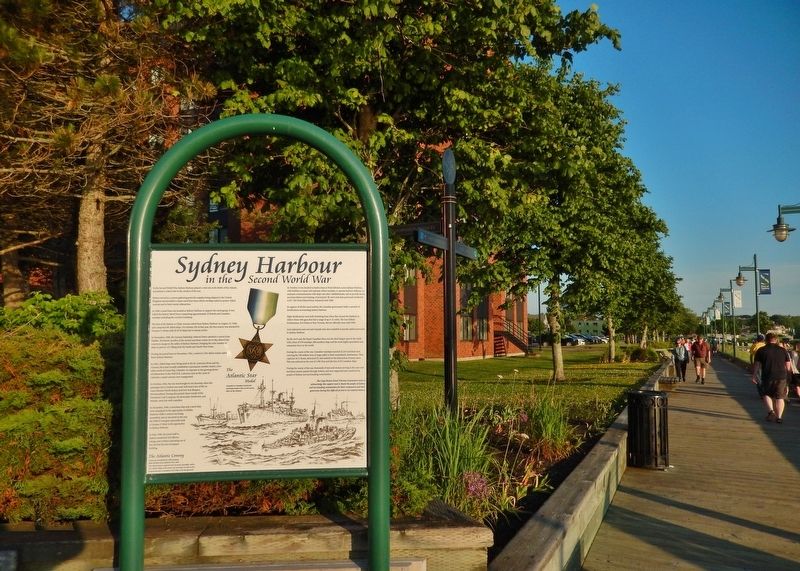Sydney in Cape Breton Region, Nova Scotia — The Atlantic Provinces (North America)
Sydney Harbour in the Second World War
In the Second World War, Sydney Harbour played a vital role in the Battle of the Atlantic and played a critical role in the conduct of the war.
Sydney served as a convoy gathering point for supplies being shipped to the United Kingdom and provided a major naval base from which warships sailed to protect Allied convoys and to hunt enemy submarines.
In 1940, a naval base was located at Sydney Harbour to support the naval group. It was called the Sydney Naval Force comprising approximately 22 British and Canadian warships including the corvette Louisburg.
The first of the Sydney to Clyde convoys sailed from Sydney Harbour on August 14, 1940, and comprised 40 Allied ships. On October 5th of that year, the first convoy was attacked by German U-Boats; with 20 of 34 ships lost to enemy action.
In November, 1940, the German battleship Admiral Scheer attacked a convoy from Halifax. The heroic sacrifice of the armed merchant cruiser Jervis Bay allowed the convoy to escape to the safety of Sydney Harbour, bringing the total number of ships in port to 127, filling both the South and North West Arms.
During the period June to November, 1941, a total of 1,764 Allied vessels sailed from Sydney Harbour.
In 1942, Allied ships were being sunk in the St. Lawrence River and the German Navy had actually established a permanent weather station a few miles north of Goose Bay, Labrador. In response to the growing threat of submarines in the Gulf of St. Lawrence and on the coast of Labrador, coastal convoys were inaugurated.
In October, 1942, the war was brought to our doorstep when the passenger ferry Caribou was sunk with heavy loss of life on route between North Sydney and Port Aux Basques, Newfoundland. During this period, three vessels of the Dominion Coal Company, the Rosecastle, Strathcona, and Watuka, were lost with casualties.
In December, 1944, a merchant ship and a naval ship were torpedoed in the approaches to Halifax Harbour while a convoy was being assembled; and at one point in the war, the HMCS Georgian reportedly sank a German U-Boat in the approaches to Sydney Harbour.
In May, 1940, the naval staff in Sydney numbered 120 officers, ratings, and civilians operating out of the old Post Record newspaper building.
In October, it was decided to build a base at Point Edward, across Sydney Harbour, with facilities to repair and maintain Allied warships, to operate harbour defenses, to maintain communications with ships and other establishments, and to provide stores, accommodation and training, of personnel. By war's end, base personnel numbered 2,327. The Point Edward base remained until 1960.
In
support of all this naval activity, the Canadian government built a network of fortifications surrounding Sydney Harbour.
Eight fortifications were built stretching from Glace Bay around the Harbour to Alder's Point with guns that had a range of up to 21 miles. The last of these fortifications, Fort Petrie at New Victoria, did not officially close until 1956.
Anti-submarine nets and anti-torpedo nets were installed to provide added protection to Sydney Harbour.
By the war's end, the Royal Canadian Navy was the third largest navy in the world with a fleet of 378 warships, 400 auxiliary ships and the most highly specialized anti-submarine force in the world.
During the course of the war, Canadian warships escorted 25,343 merchant men carrying the 180 million tons of cargo safely to their transatlantic destinations. They captured 24 U-Boats, destroyed 23, and assisted in the destruction of many more. This was achieved at the cost of 1,981 lives and the loss of 24 Canadian ships.
During the course of the war, thousands of men and women serving in the navy and merchant marine passed through Sydney, and were supported and comforted by people of Sydney and surrounding communities.
The Cape Breton Naval Veterans Association want to acknowledge this support and to thank the people of Sydney and surrounding communities for their compassion and
their generosity during this difficult period in our nation's history.
Topics. This historical marker is listed in these topic lists: War, World II • Waterways & Vessels. A significant historical month for this entry is May 1940.
Location. 46° 8.193′ N, 60° 11.79′ W. Marker is in Sydney, Nova Scotia, in Cape Breton Region. Marker can be reached from Wentworth Street just west of Esplanade (Nova Scotia Route 4), on the left when traveling west. Marker is located along the Sydney Waterfront Boardwalk, on the south side of Wentworth Street. Touch for map. Marker is in this post office area: Sydney NS B1P 6P4, Canada. Touch for directions.
Other nearby markers. At least 8 other markers are within walking distance of this marker. Canadian Merchant Navy (approx. 0.4 kilometers away); Sydney's Heritage Conservation District (approx. 0.4 kilometers away); J.F.W. DesBarres (approx. 0.4 kilometers away); St. George's Church (approx. 0.6 kilometers away); Royal Bank Lion (approx. 0.7 kilometers away); Joseph Frederick Wallet DesBarres (approx. 0.7 kilometers away); Sir John George Bourinot (approx. 0.7 kilometers away); Cossit House (approx. 0.8 kilometers away). Touch for a list and map of all markers in Sydney.
Related markers. Click here for a list of markers that are related to this marker. World War II Fortifications around Sydney, Nova Scotia
Also see . . .
1. HMCS Protector, also known as the Point Edward Naval Base. Wikipedia entry:
During the
months prior to the Second World War being declared in 1939, the RCMP Patrol Vessel Protector was stationed at Sydney for various policing duties. On 28 August 1939 the Royal Canadian Navy established a small shore facility on the Sydney waterfront. On 22 July 1940, this facility was commissioned as HMCS Protector, taking its name from Patrol Vessel Protector. At the time, navy regulations stated that a naval shore base's designation must use a seaborne ship's name. (Submitted on June 21, 2020, by Cosmos Mariner of Cape Canaveral, Florida.)
2. War comes to Sydney Harbour. Legion Magazine website entry:
Sydney played a significant role in the Second World War as the second-most-important port for convoy formation after Halifax. In those days before Newfoundland joined Canada, Sydney was known as the most easterly city in North America, which meant between 1939 and 1945, it was also the Canadian city closest to the war. When France, Belgium and the Netherlands collapsed, Britain was cut off from its major sources of supply in Continental Europe. It became dependent on Canada and the neutral United States for most of its food, lumber and fuel, let alone the men, women and supplies to help fight the war. (Submitted on June 21, 2020, by Cosmos Mariner of Cape Canaveral, Florida.)
Credits. This page was last revised on September 26, 2023. It was originally submitted on June 20, 2020, by Cosmos Mariner of Cape Canaveral, Florida. This page has been viewed 1,267 times since then and 704 times this year. Photos: 1, 2, 3, 4. submitted on June 21, 2020, by Cosmos Mariner of Cape Canaveral, Florida.



